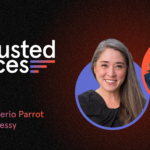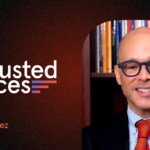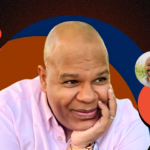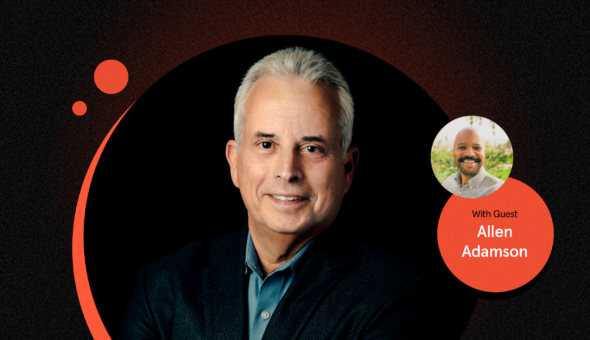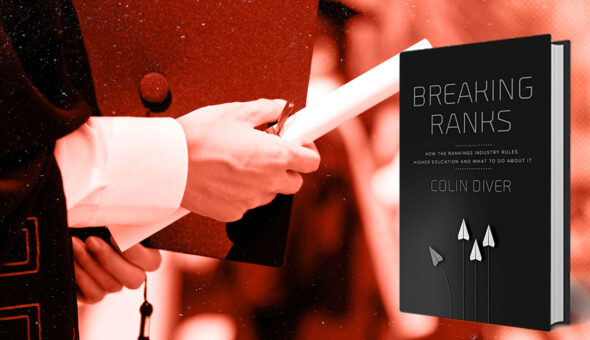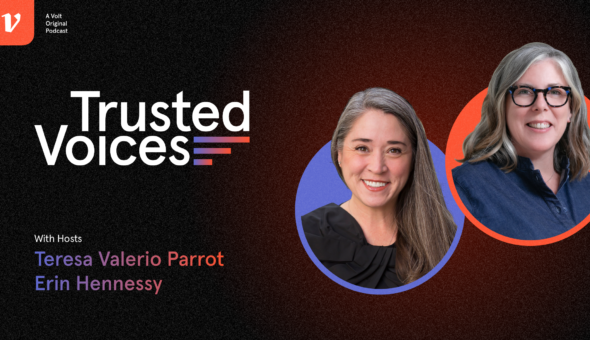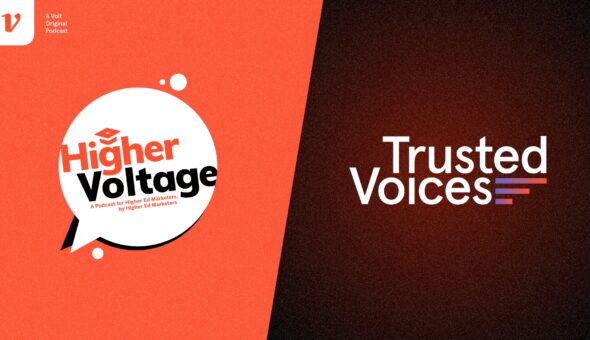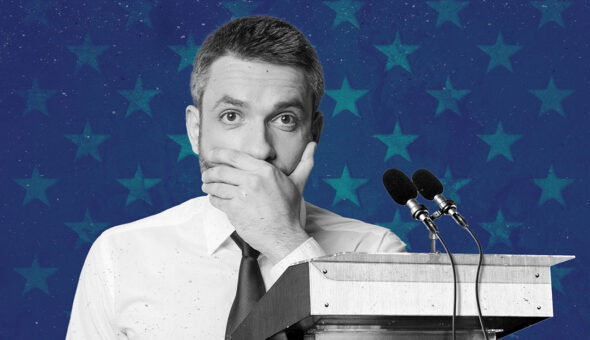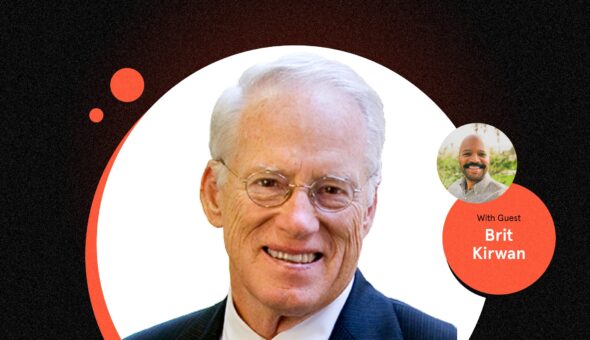The job of college or university president doesn’t come with a manual, and one of the trickiest areas to navigate is the management of intercollegiate athletics. That knowledge gap—and the potential ways to bridge it—is one of the biggest takeaways that Teresa and Erin got from their conversation earlier this week with Amy Privette Perko, chief executive officer of the Knight Commission on Intercollegiate Athletics.
Listen as they explore that and other insights they took from that conversation.
Show notes
- United Soccer Coaches Coach Credentialing Program (United Soccer Coaches)
- Knight Commission Criticizes Commercialization of College Athletes in Fantasy Sports, New Media (Knight Commission)
- White Paper: The NCAA and “Non-Game Related” Student-Athlete Name, Image and Likeness Restrictions (Knight Commission)
- NCAA Announces Massachusetts Gov. Charlie Baker as Next President (ESPN)
Read the full transcript
Erin Hennessy:
Hello, and welcome to part two of the Trusted Voices Podcast. I’m Erin Hennessy, alongside Teresa Valerio Parrot. After each episode, we take some time together to digest our conversation with our most recent guest and to come back and share what we’ve learned, what we’d like to learn more about, and resources we’ve found helpful in thinking about these topics. If you haven’t had a chance to listen to our conversation yet, I encourage you to swirl back in your feed and hit play.
Teresa Valerio Parrot:
In part one of this episode, we talked with Amy Perko of the Knight Commission about a wide array of topics related to intercollegiate athletics. Erin, it’s been a couple of days. What stuck out to you the most in this conversation?
Erin Hennessy:
I keep coming back to what I think was a really innovative program that Amy mentioned put together by United Soccer, I believe, that provides, I think she said it was 60 hours of curriculum that ends in a credential certifying an individual to be a college-level coach.
And I thought that was fascinating, and I first of all thought about how that could be expanded to other programs across intercollegiate athletics, but then I really started to think about what kind of curriculum we would put together for presidents and boards of trustees. For a completely different project, I was looking back at the 2017 version of ACE’s, American College President Survey and looking at the areas that surveyed presidents indicated they were least prepared to deal with when they came into the role of president and athletics is at the top of that list. I know a lot of presidential development programs include a conversation about athletics and compliance and things like that, but I just keep coming back to the thought of what would a curriculum for presidents and boards look like to get them ready to provide leadership and oversight of collegiate athletic programs?
Teresa Valerio Parrot:
Well, it’s funny you should ask that. You literally don’t even know what I’m about to say. You just described my dissertation. So the final takeaway, because I just finished the final draft of chapter five, which is your recommendations was to create a leadership framework for the governance of intercollegiate athletics. And you’re spot on with some of what I pull into this.
And the way that I framed that was to provide guiding questions and conversation starters. And one of the findings from my research was that boards and presidents admitted they didn’t know what these jobs entailed when they took it on. And some of them still are unclear on what that looks like. Not my presidents, they both are stellar presidents in this area for my dissertation, but the boards said, “We know most of what we’re supposed to be doing, but is there anything else we’re supposed to be doing?” And I think that’s a really scary place for boards to be right now in United States.
Interestingly, going back to the ACE presidents survey that you’re talking about, there is this question that was asked about what keeps you up at night? What are you most worried about? And athletics was at the top of that list. And at the same time we see there are a couple of topics that rise to the top of the list of what cause involuntary presidential transitions, or as we like to call them firings. And both governance and intercollegiate athletics are at the top of that list.
Interestingly, AGB has its survey of board members as well, and they do ask board members about what it is that they’re concerned about that they may face in the future, but athletics isn’t listed as one of the options as a response. So there is this interesting spot where we are asking, what are you worried about, but we’re not connecting all of the dots about where it is that presidents and boards have vulnerability when it comes to the governance of intercollegiate athletics.
Erin Hennessy:
Yeah, I think that’s such a good point. And I swear to our listeners, I was not attempting to tee Teresa her not to talk about our dissertation again.
Teresa Valerio Parrot:
Thank you. Thank you.
Erin Hennessy:
But.
Teresa Valerio Parrot:
Again, sorry everybody. I’m done in a month and five days. And so after that, hopefully y’all don’t have hear about this.
Erin Hennessy:
And then we’re going to have a month prohibition on the word dissertation. But I keep thinking back to when I was at ACE navigating or watching higher education navigate the Sandusky issues at Penn State. And the conversations that came out of that at other institutions and across the industry really focused on whether or not presidents were engaged enough in athletics, particularly big time collegiate athletics, whether or not they were sort of abdicating their responsibilities and letting in many cases the AD and the football coach sort of run that part of the institutional enterprise free of any kind of oversight from the president’s office because it was believed to be better to have plausible deniability. That, gosh, if there’s an issue, I had no idea, because that happens over there.
And I think I’m hopeful that Penn State and some of the other large athletic scandals that we’ve seen in recent years are really putting a stop to that kind of approach to managing the athletics enterprise and really encouraging presidents and boards to ask the hard questions to raise the big issues. But if we aren’t sufficiently training them to do that, can we expect that they do that?
Teresa Valerio Parrot:
Well, I think there is the question about are we training them? But I also think I’m going to go back to what Amy was talking to us about, and that is fundamentally there is this issue tied to athletics that the NCAA is a member organization. And so some of why change doesn’t happen is because I do think that presidents think that they might be safer if they aren’t defining these areas, if they aren’t clarifying some of these places where we need clarification because they think it’s going to protect them more. And as you and I both know, it actually adds to the vulnerabilities. So if they think not addressing it is a safer way to go, I would strongly encourage them to rethink that position.
And Amy talked about this a bit. There were a couple of things that she mentioned, including, this goes back to the NCAA, but again, it’s a member organization, so this brings the presidents into the conversations as well. And that’s that she mentioned that when the NCAA and athletics is under fire in so many ways, you would think that they would want to actually act more quickly. And as we’ve seen, that’s not always how this goes. So again, how are presidents who are on the board and are the people who run the member organization thinking about what their roles and responsibilities are, the timeliness with which they need to act when this environment is moving so quickly? And I worry that a number of institutions are just watching it all go by until there’s going to be a problem.
Erin Hennessy:
Yeah, yeah. It kind of blew my mind when Amy said, I think we were talking about NIL, and she said, well, the NCAA is just openly not enforcing their rules around NIL.
Teresa Valerio Parrot:
The NCAA has failed to enforce its own rules. And we see that. If you watch the collective conversations right now, some of these collectives are forming as nonprofits. Some of them are very clear they don’t hit the threshold for being a nonprofit. Some of them are flagrantly looking at the rules and saying, “We’re going to go exactly to where we’ve been told not to go.” And because the NCAA conducts its investigations privately, nobody knows if they actually are looking into these situations or if the NCAA is failing to enforce its own rules. That veil of secrecy, which I think is meant not to throw others under the bus and to allow you to be innocent until proven guilty, in this case, is allowing others to follow the lead of those who are raising millions of dollars.
Erin Hennessy:
Well, and it comes back to me over and over again that to your point, nothing’s going to change until there’s some kind of scandal or major blowup. And we so often forget, and it’s so easy when you’re watching ESPN or sitting in front of the loudmouth guy at a college basketball game, these are students. And what the NCAA is doing by not enforcing its own rules is making students vulnerable.
And you and I have been around long enough to know that there will be some big newspaper story, some big expose somewhere about how a student was harmed in some way, and the NCAA could have prevented it by enforcing their rules and golly gee, we had no idea if we had only known and et cetera, et cetera.
So remembering that it is students at the center of all this and that it is students who are impacted positively or negatively by the choices and the decisions that the NCAA and its board makes. I just think that sort of gets forgotten so often until it becomes front page news and people ask that question of why wasn’t this being paid its proper attention?
Teresa Valerio Parrot:
And Amy gave us some excellent examples of where these conversations are being raised, and they may or may not be under review or being adjusted. And to your point, there is this unintentional consequence that often we look back and say, “Wow, this really hurt students.” This unintentional consequence to them, and they become collateral damage in situations that have been raised previously.
So if we go back to Amy mentioning that in 2008, the Knight Commission released a study on what became NIL, I think that’s fascinating, and I’m going to quote from this. So Gerald Turner was the co-chair with Brit Kerwin and Gerald Turner is quoted as saying, “College athletes in fantasy games and video games may seem trivial to some, but these and other forms of new media pose new challenges to the long held distinction between commercial activity featuring teams and that which focuses on individual athletes.” This was in 2008, so here we are in 2023 and people are saying, “This is coming at us so fast,” and it is coming at us so fast from 2008.
Erin Hennessy:
Yeah. And the only thing is that’s changed is some of the terms and the technology, I mean the NFTs and all of this stuff, but the court issues are the same. We didn’t talk to Amy about this on a personal level, but I do wonder how she continues to do this work and what her personal level of frustration is, because the Knight Commission has been really just sort of watch dogging the NCAA for so long, and they’ve had some really important victories and moved the industry and the conversation forward in some really important ways.
But to your point, they’ve been watching this NIL issue for years and years and years, and folks are just waking up to it today. So I do wonder how you manage that kind of personal frustration. But I’m really glad that Amy continues to do this work and that folks continue to serve on the Commission because they are, I think, a really important voice and watchdog for student athletes.
Teresa Valerio Parrot:
And I feel like I need to give a little bit of love to Jeremy Bloom because anytime I can give a little love to Jeremy Bloom, I do, because I think he raised some important considerations, and he’s the former University of Colorado football player who in 2004, he wanted to receive an injunction that would allow him to get endorsements for his Olympic ski career. I just want to point this out. This gentleman played in Division I football at an institution and also was an Olympic skier.
And the way that Olympic skiing works is that you have to have sponsors for your equipment, for your travel, for your coaches, for all of the things. And he wasn’t allowed to get endorsements from the ski industry to support his Olympic endeavors because that was seen as risking his eligibility to play college football. I just want to raise that’s who Jeremy Bloom was, and that was in 2004, and the court denied the injunction because they said that this was in conflict and a clear demarcation between intercollegiate athletics and professional sports. And I just think about how far we’ve come in these almost 20 years since then, and I just go back to the fact that that wasn’t a judgment that was best for a student athlete that purely was a maintenance of how we all like to think about the purity of sport.
Erin Hennessy:
Yeah, we could do hours on this.
Teresa Valerio Parrot:
I know. I do want to be very clear on something though. Sorry.
Erin Hennessy:
No, no, go ahead.
Teresa Valerio Parrot:
And that is, sports do great things, and Amy talked about this, right? Whether it’s time management, learning leadership skills, being able to practice what you love. I mean, there’s so many great things that come from athletics, and I don’t want for us to forget that. But I also think that we have an obligation to our student athletes to be treating them with respect and to be ensuring that how we talk about athletics is how it’s implemented and lived.
Erin Hennessy:
Yes. And you and I had vastly different collegiate experiences, and athletics was a very small part of mine. I was at a Division III institution. I was not a student athlete. But I do want to add to what you’re saying at a lot of places, this is being done right and there are good people with good intentions who are following all the rules and are probably, talking about frustration, deeply frustrated to see other institutions, competitors, colleagues, whomever, not playing by the rules or leaning into loopholes in gray areas that benefit their institution, their team, their program.
I do think that, however, when you talk about the kind of money that is in collegiate athletics, and thinking back to Amy talking about increasing in revenues for, see, this is where I get in trouble, football, I think, is what we were talking about. When you talk about that kind of money, it’s very, very hard for people, even with the best of intentions and a focus on the student athlete experience to do the right thing when you’re talking about billions and billions of dollars and what your institutional share of that is, and how much you’ve already put into a program and how much pressure you’re under from boosters and alums to make it to the playoffs to make it to Final Four and make it to whatever the thing is. There’s just so many opportunities for this good thing that does great stuff for our students to be perverted because of money, because of ambition, because of any number of things. So to your point, we talk about the purity of intercollegiate athletics, and not everybody is focused on that goal.
Teresa Valerio Parrot:
Right. And that’s a big sigh. Oh, I do want to return to one more topic. That was the thread throughout the conversation, and that was Title IX. I thought that Amy did a fantastic job of sharing what the recommendations were from the Knight Commission on Title IX and specifically looking at women’s basketball, and then also talking about how there was this alignment between what the Knight Commission suggested and the NCAA’s own report encouraged and that it wasn’t fully implemented. And it goes back to what you were just saying. It’s all about the Benjamins, right? It goes back to the money. And I thought that was fascinating, and I will be interested to see, because the Knight Commission is so smart on the issues it takes on how it does that, and when it drops its reports to see what we might have ahead as we head into March Madness.
Erin Hennessy:
Yeah. I keep coming back to that clip. I think it was it Kai Ryssdal was interviewing Emmert, sort of a look back on his career as he left and asked very pointedly about the experience of women collegiate athletes, and Emmert said all the right things about this continuing to be a focus and a priority moving forward. And whoever the reporter was, I do think it was Kai Ryssdal came back and said, “Well, yeah, but you were in the job for 13 years. You could have moved the needle on this.” And that, I think, was a very telling moment. I hope that this is top of the priority list for Governor Baker when he joins the NCAA, but as you said, we know the Knight Commission will be watching, and I’m interested to see as well what they have to say about whether or not progress has been made.
Teresa Valerio Parrot:
And I think it would only be appropriate for our wrap up episode if we talked about really quickly that this isn’t a communications issue. This isn’t a storytelling problem. This is a leadership problem. Because in this case, to your point, he said the right things. That means that the communicator had him prepped that that means that there was training that went on. That means that there is a strategy that has been written. You can have all of those things, but if the decisions aren’t being made behind the scenes, then you get that tough follow up question that says, and why aren’t you doing the hard work?
Erin Hennessy:
Yeah. Yep.
Teresa Valerio Parrot:
So on that note, let’s go ahead and wrap this episode three. Thank you for joining us again on Trusted Voices. We look forward to being back in your feed in a couple of weeks with a new guest in continuing conversations about higher education’s leadership and communications. Until then, on behalf of Erin Hennessy, our thanks to DJ Hochschild, Aaron Stern, and the Volt team for another great episode.
